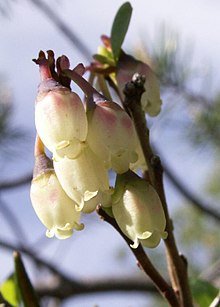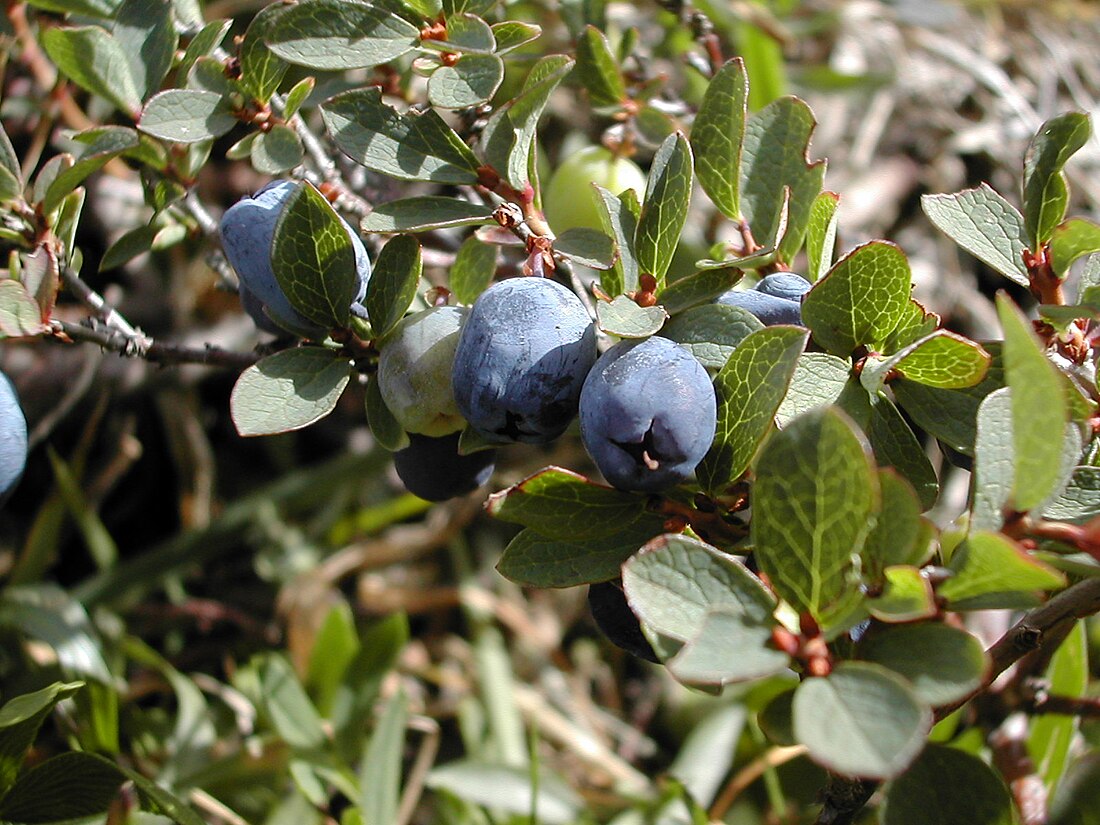Vaccinium uliginosum
Berry and plant From Wikipedia, the free encyclopedia
Vaccinium uliginosum (bog bilberry, bog blueberry,[3] northern bilberry or western blueberry)[4] is a Eurasian and North American flowering plant in the heath family Ericaceae.
| Vaccinium uliginosum | |
|---|---|
 | |
 | |
| Scientific classification | |
| Kingdom: | Plantae |
| Clade: | Tracheophytes |
| Clade: | Angiosperms |
| Clade: | Eudicots |
| Clade: | Asterids |
| Order: | Ericales |
| Family: | Ericaceae |
| Genus: | Vaccinium |
| Species: | V. uliginosum |
| Binomial name | |
| Vaccinium uliginosum | |
| Synonyms[2] | |
| |
Description
Vaccinium uliginosum is a small deciduous shrub growing to 10–75 centimetres (4–29+1⁄2 inches) tall, rarely 1 metre (3+1⁄2 feet) tall, with brown stems (unlike the green stems of the closely related bilberry). The leaves are oval, 4–30 millimetres (1⁄8–1+1⁄8 in) long and 2–15 mm (1⁄16–9⁄16 in) wide, blue-green with pale net-like veins, with a smooth margin and rounded apex.[5]
The flowers are pendulous, urn-shaped, pale pink, 4–6 mm (3⁄16–1⁄4 in) long, produced in mid-spring. The fruit is a dark blue-black berry 5–8 mm (3⁄16–5⁄16 in) in diameter, with a white sweet flesh, ripe in late summer.[5] Cytology is 2n = 24.[6]
Subspecies
Three subspecies have been described, but not all authorities distinguish them:[2][5]
- Vaccinium uliginosum subsp. microphyllum Lange – Arctic plants
- Vaccinium uliginosum subsp. occidentale (A.Gray) Hultén – North American plants
- Vaccinium uliginosum subsp. uliginosum
Distribution and habitat
The plant is native to cool temperate regions of the Northern Hemisphere, at low altitudes in the Arctic, Baltics, and at high altitudes south to the Pyrenees, the Alps, and the Caucasus in Europe, the mountains of Mongolia, northern China, the Korean Peninsula and central Japan in Asia, and the Sierra Nevada in California and the Rocky Mountains in Utah in North America.[5][7][8][9]
It grows on wet acidic soils on heathland, moorland, tundra,[10] and in the understory of coniferous forests, from sea level in the Arctic, up to 3,400 m (11,200 ft) altitude in the south of the range.
V. uliginosum can survive long, severe climatic oscillations.[11][12]
Uses
The berries can be eaten raw or cooked, used to make jelly or pies, or dried to make pemmican.[13]
In Korean cuisine, bog bilberry is used to make infused liquor (Deuljjuk-sul).
Gallery
- Bilberries on branches
- Close-up of bilberries in Eastern Siberia
- Bog bilberry liquor (left) produced in North Korea
References
Further reading
External links
Wikiwand - on
Seamless Wikipedia browsing. On steroids.




